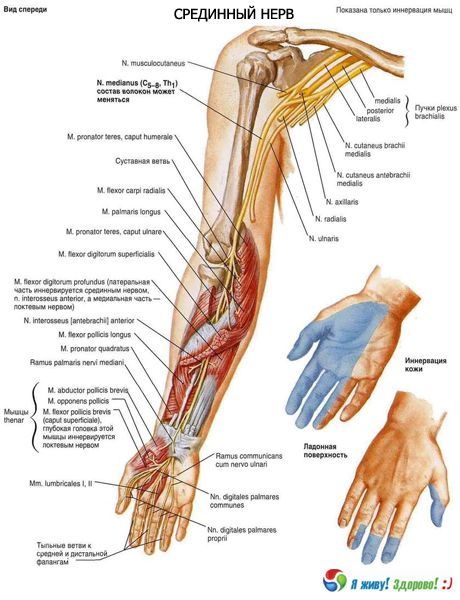Median nerve
Last reviewed: 20.11.2021

All iLive content is medically reviewed or fact checked to ensure as much factual accuracy as possible.
We have strict sourcing guidelines and only link to reputable media sites, academic research institutions and, whenever possible, medically peer reviewed studies. Note that the numbers in parentheses ([1], [2], etc.) are clickable links to these studies.
If you feel that any of our content is inaccurate, out-of-date, or otherwise questionable, please select it and press Ctrl + Enter.
The median nerve (n. Medianus) departs from the fusion of lateral and medial bundles of the brachial plexus of the fibers of the anterior branches of the sixth to eighth cervical and first thoracic (CVI-ThI) spinal nerves. Both bundles are connected at an acute angle in front of the axillary artery. On the shoulder, the median nerve passes first in one fascial case with the brachial artery, lateral to it. The projection of the median nerve corresponds to the location of the medial groove of the shoulder. At this level, the median nerve often has a connecting branch with the musculocutaneous nerve. Further downwards, the median nerve first curves around the brachial artery from the outside, then at the level of the lower half of the shoulder it goes medial to the brachial artery and gradually moves away from it to the inside. At the level of the ulnar fold, the median nerve is located 1.0-1.5 cm medial to the brachial artery, then passes under the aponeurosis of the biceps arm muscle and descends between the heads of the round pronator. Then the nerve goes down between the superficial and deep flexors of the fingers. In the lower part of the forearm, the median nerve is located between the tendon of the radial flexor of the wrist medially and the long palmar muscle laterally. On the palm, the nerve passes through the wrist canal.

On the shoulder and in the ulnar fossa, the median nerve of the branches does not give. On the forearm from it go muscular branches to the round and square pronators, the superficial flexor palpate, the long flexor of the thumb of the hand, the long palmar muscle, the radial flexor of the wrist, the deep flexor of the fingers (towards the lateral part). The median nerve innervates all the muscles of the anterior group of the forearm, except for the medial part of the deep flexor of the fingers and the ulnar flexor of the wrist. The nerve also gives the sensitive branches to the elbow joint. The largest branch of the median nerve on the forearm is the anterior interosseous nerve (n. Interosseus anterior). It lies on the anterior surface of the interosseous membrane of the forearm along with the anterior interosseous artery, innervates the deep muscles of the forearm forearm and the capsule of the wrist joint, the interosseous membrane and the bones of the forearm.
At the level of the wrist joint from the median nerve, the palmar branch departs. It penetrates the fascia of the forearm and is directed further between the tendons of the radial flexor of the wrist and the long palmar muscle. The palmar branch of the median nerve (r. Palmaris n. Mediani) innervates the skin of the lateral half of the wrist and part of the skin of the thumb's elevation.
On the wrist, the median nerve innervates the short muscle that removes the thumb; the muscle that opposes the thumb of the hand, the superficial head of the short flexor of the thumb, the 1st and 2nd wormlike muscles. Under the palmar aponeurosis, the median nerve is divided into three common palmar fingernails (nn. Digitales palmares communes). These nerves pass along the first, second and third interstitial spaces and innervate the skin of three and a half fingers on the palmar side of the hand. The first common palmar nerve innervates the first worm-like muscle and gives off three skin branches - its own palmar finger nerves (nn. Digitales palmares proprii). Two of them pass along the radial and ulnar sides of the thumb, the third - along the radial side of the index finger. The second and third common palmar nerves give away two of their own palmar fingertips. These nerves go to the skin of the sides of the first, second and third fingers facing each other and to the skin of the back sides of the distal and middle phalanges of the 2nd and 3rd fingers. The second common palmar finger nerve also innervates the 2nd vermiform muscle. The median nerve innervates the wrist joints and the first four fingers.
What do need to examine?
How to examine?

